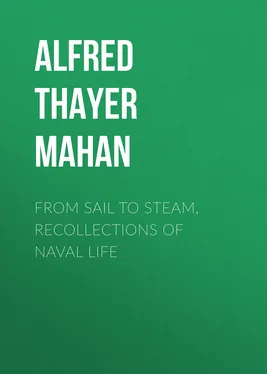Alfred Thayer Mahan - From Sail to Steam, Recollections of Naval Life
Здесь есть возможность читать онлайн «Alfred Thayer Mahan - From Sail to Steam, Recollections of Naval Life» — ознакомительный отрывок электронной книги совершенно бесплатно, а после прочтения отрывка купить полную версию. В некоторых случаях можно слушать аудио, скачать через торрент в формате fb2 и присутствует краткое содержание. Жанр: foreign_prose, История, foreign_edu, foreign_antique, на английском языке. Описание произведения, (предисловие) а так же отзывы посетителей доступны на портале библиотеки ЛибКат.
- Название:From Sail to Steam, Recollections of Naval Life
- Автор:
- Жанр:
- Год:неизвестен
- ISBN:нет данных
- Рейтинг книги:3 / 5. Голосов: 1
-
Избранное:Добавить в избранное
- Отзывы:
-
Ваша оценка:
- 60
- 1
- 2
- 3
- 4
- 5
From Sail to Steam, Recollections of Naval Life: краткое содержание, описание и аннотация
Предлагаем к чтению аннотацию, описание, краткое содержание или предисловие (зависит от того, что написал сам автор книги «From Sail to Steam, Recollections of Naval Life»). Если вы не нашли необходимую информацию о книге — напишите в комментариях, мы постараемся отыскать её.
From Sail to Steam, Recollections of Naval Life — читать онлайн ознакомительный отрывок
Ниже представлен текст книги, разбитый по страницам. Система сохранения места последней прочитанной страницы, позволяет с удобством читать онлайн бесплатно книгу «From Sail to Steam, Recollections of Naval Life», без необходимости каждый раз заново искать на чём Вы остановились. Поставьте закладку, и сможете в любой момент перейти на страницу, на которой закончили чтение.
Интервал:
Закладка:
II
NAVAL CONDITIONS BEFORE THE WAR OF SECESSION
Less far-reaching, because men are greater than ships, but still of immense timeliness as a preparative to the war, was the reconstitution of the material of the navy, practically coincident with the regeneration of the personnel. The causes which led to this are before my time, and beyond my contemporary knowledge. They therefore form no part of my theme; but the result, which is more important than the process, was strictly contemporary with me. It marked a definite parting with sails as the motive reliance of a ship-of-war, but at the same time was characterized by an extreme conservatism, which then was probably judicious, and certainly represented the naval opinion of the day. It must be remembered that the Atlantic was first crossed under steam in 1837, a feat shortly before thought impossible on account of coal consumption, and that the screw-propeller was not generally adopted till several years afterwards. In 1855 the transatlantic liners were still paddlers; but the paddle-wheel shaft was far above the water, and so, in necessary consequence, was much of the machinery which transmitted power from the boilers to the wheel. All battle experience avouched the probability of disabling injury under such exposure; not more certain, but probably more fatal, than that to spars and sails of sailing-ships. Despite this drawback, paddle wheel men-of-war were being built between 1840 and 1850. Our own navy had of these two large and powerful vessels, sisters, the Missouri and the Mississippi . Singularly enough, both met the same end, by fire; the Missouri being burned in the Bay of Gibraltar in 1843, the Mississippi in the river whence she took her name, in the course of Farragut's passage of the batteries at Port Hudson in 1863. This engagement marked the end of the admiral's achievements in the river, throughout which, beginning with the passage of the forts and the capture of New Orleans, the Mississippi had done good work. At the time of her destruction, the present Admiral Dewey was her first lieutenant. Besides these two we had the Susquehanna , "paddle-wheel steam-frigate," which also served manfully through the war, and was in commission after it. It was she that carried General Sherman on his mission to Mexico in 1866. As usual, the principal European navies had built many more of these vessels; that is, had adopted improvements more readily than we did. During my first cruise after graduation, on the coast of Brazil, 1859–61, the British squadron there was composed chiefly of paddlers; the flag-ship Leopard being one. As I remember, there was only one screw-steamer, the sloop-of-war Curaçao .
By that time, however, the paddlers were only survivals; but it may be noted, in passing, with reference to the cry of obsolescence so readily raised in our day, that these survivals did yeoman service in the War of Secession. It is possible to be too quick in discarding, as well as too slow in adopting. By 1850 the screw had made good its position; and the difficulty which had impeded the progress of steam in men-of-war disappeared when it became possible to place all machinery below water. There were, however, many improvements still to come, before it could be frankly and fully accepted as the sole motive power. It is not well to let go with one hand till sure of your grip with the other. So in the early days of electric lighting prudent steamship companies kept their oil-lamps trimmed and filled in the brackets alongside of the electric globes. Apart from the problem experienced by the average man—and governments are almost always averages in adjusting his action to novel conditions, the science of steam-enginery was still very backward. Notably, the expenditure of coal was excessive; to produce a given result in miles travelled, or speed attained, much more had to be burned than now, a condition to which contributed also the lack of rigidity in the wooden hulls, which still held their ground. Sails were very expensive articles, as I heard said by an accomplished officer of the olden days; but they were less costly than coal. Steam therefore was accepted at the first only as an accessory, for emergencies. It was too evident for question that in battle a vessel independent of the wind would have an unqualified advantage over one dependent; though an early acquaintance of mine, a sailmaker in the navy, a man of unusual intelligence and tried courage, used to maintain that steam would never prevail. Small steamers, he contended, would accompany sailing fleets, to tow vessels becalmed, or disabled in battle; a most entertaining instance of professional prepossession. What would be his reflections, had he survived till this year of grace, to see only six sailmakers on the active list of the navy, the last one appointed in 1888, and not one of them afloat. Likewise, in breasting the continuous head-winds which mark some ocean districts, or traversing the calms of others, there would be gain; but for the most part sailing, it was thought, was sufficiently expeditious, decidedly cheaper, and more generally reliable; for steamers "broke down." Admiral Baudin; a French veteran of the Napoleonic period, was very sarcastic over the uncertainties of action of the steamers accompanying his sailing frigates, when he attacked Fort San Juan de Ulloa, off Vera Cruz in 1839; and since writing these words I have come across the following quotation, of several years later, from the London Guardian , which is republishing some of its older news under the title "'Tis Sixty Years Since."
"Naval manœuvres in 1846. The Squadron of Evolution is one of the topics of the present week (June 10, 1846). Its arrival in the Cove of Cork, after a cruise which has tested by every variety of weather the sailing qualities of the vessels, has furnished the world with a few particulars of its doings, and with some materials for speculating on the problems it was sent out to solve. The result, as far as it goes, is certainly unfavorable to the exclusive prevalence of steam agency in naval warfare. Sailing ships, it is seen, can do things which steamers, as at present constructed, cannot accomplish. They can keep the sea when steamers cannot. But the screw-steamer, which is reported to have astonished everybody, is certainly an exception. Perhaps by this contrivance the rapidity and convenience of steam locomotion may be combined with the power and stability of our huge sailing batteries."
Under convictions thus slowly recasting, the first big steam ships-of-war carried merely "auxiliary" engines; were in fact sailing vessels, of the types in use for over a century, into which machinery was introduced to meet occasional emergencies. In some cases, probably in many, ships already built as sailers were lengthened and engined. As late as 1868 we were station-mates with one such, the Rodney , of 90 guns, then the flag-ship of the British China squadron; and we had already met, another, the Princess Royal , at the Cape of Good Hope, homeward bound. She, however, had been built as a steamer. She was a singularly handsome vessel, of her majestic type; and, as she lay close by us, I remember commenting on her appearance to one of my messmates, poor Stewart, who afterwards went down in the Oneida . "Yes," he replied, "she possesses several elements of the sublime." They were certainly imposing creations, with their double and treble tiers of guns, thrusting their black muzzles through the successive ports which, to the number of fifteen to twenty, broke through the two broad white hands that from bow to stern traversed the blackness of their hulls; above which rose spars as tall and broad as ever graced the days of Nelson. To make the illusion of the past as complete as possible, and the dissemblance from the sailing ship as slight, the smoke-stack—or funnel—was telescopic, permitting it to be lowered almost out of sight. For those who can recall these predecessors of the modern battle-ships, the latter can make slight claim to beauty or impressiveness; yet, despite the ugliness of their angular broken sky-line, they have a gracefulness all their own, when moving slowly in still water. I remember a dozen years ago watching the French Mediterranean fleet of six or eight battle-ships leaving the harbor of Villefranche, near Nice. There was some manœuvring to get their several stations, during which, here and there, a vessel lying quiet waiting her opportunity would glide forward with a dozen slow turns of the screws, not agitating the water beyond a light ripple at the bows. The bay at the moment was quiet as a mill-pond, and it needed little imagination to prompt recognition of the identity of dignified movement with that of a swan making its leisurely way by means equally unseen; no turbulent display of energy, yet suggestive of mysterious power.
Читать дальшеИнтервал:
Закладка:
Похожие книги на «From Sail to Steam, Recollections of Naval Life»
Представляем Вашему вниманию похожие книги на «From Sail to Steam, Recollections of Naval Life» списком для выбора. Мы отобрали схожую по названию и смыслу литературу в надежде предоставить читателям больше вариантов отыскать новые, интересные, ещё непрочитанные произведения.
Обсуждение, отзывы о книге «From Sail to Steam, Recollections of Naval Life» и просто собственные мнения читателей. Оставьте ваши комментарии, напишите, что Вы думаете о произведении, его смысле или главных героях. Укажите что конкретно понравилось, а что нет, и почему Вы так считаете.












